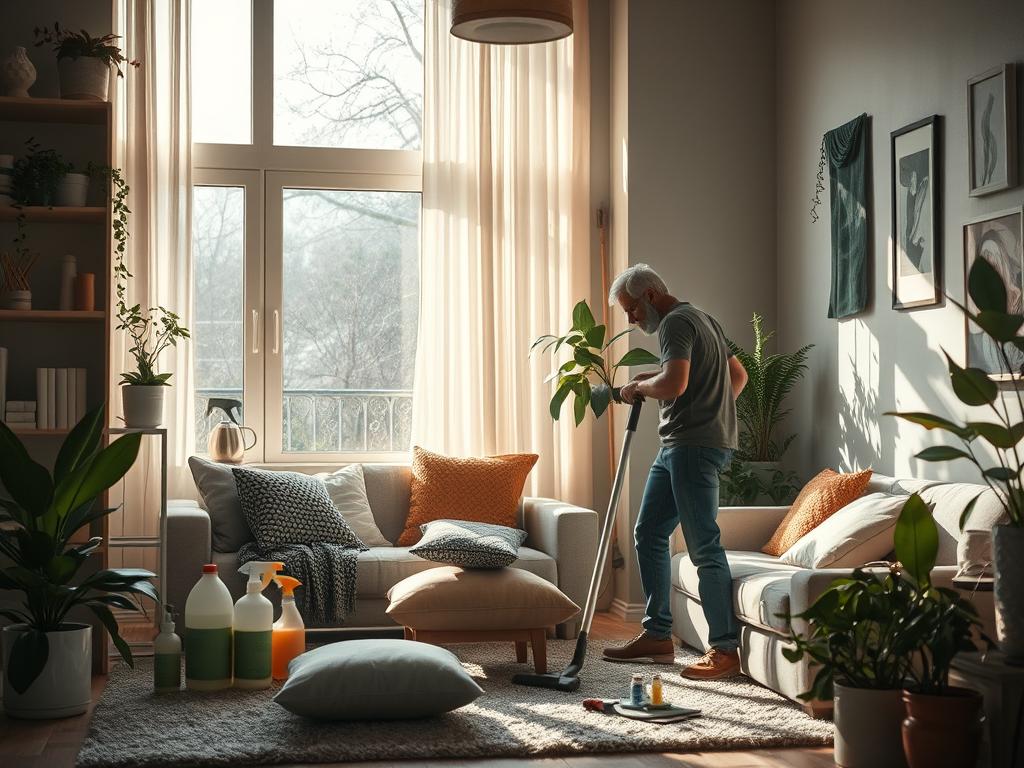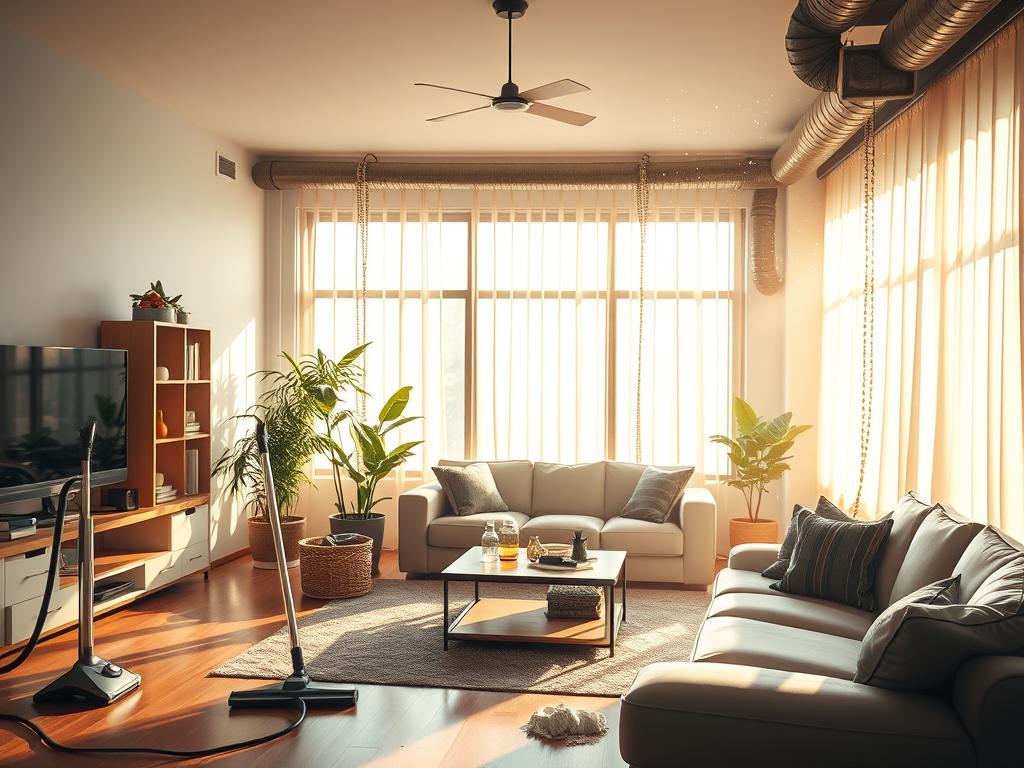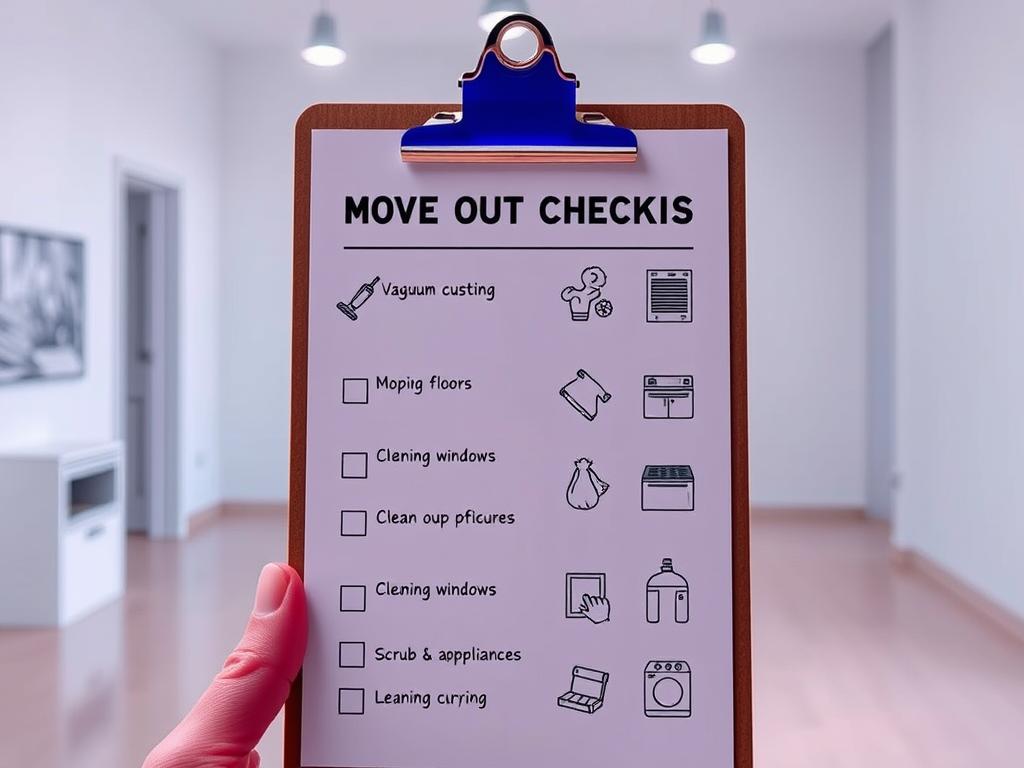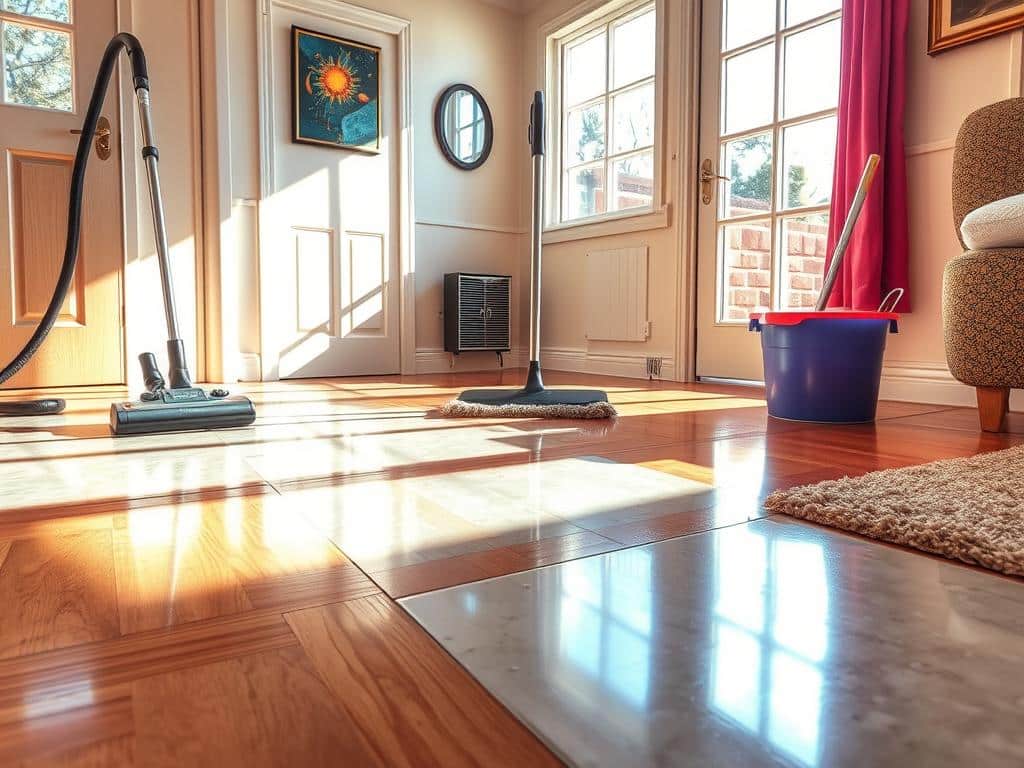
Keeping a home clean is key for controlling allergies. Today, indoor allergens affect millions every year. Cleaning practices that focus on dust mites, pet dander, and mold can cut down allergy symptoms.
Regular cleaning and professional help, like from Amenify, reduce allergens. Use HEPA vacuum cleaners and allergy-friendly products. This traps allergens and makes your home healthier.
Steam cleaning carpets and washing bedding in hot water are good too. These methods kill dust mites and tackle tough allergens in fabrics. An allergen-free home means less discomfort and fewer symptoms.
Understanding Common Household Allergens
Your home might have various indoor allergens that affect your health and comfort. Knowing these allergens is key to cleaning better and lowering exposure.
Dust Mites
Dust mites like warm, humid places and live in bedding, upholstery, and carpets. They eat dead skin cells and cause sneezing and itchy eyes. Deep cleaning rooms, especially bedrooms, is crucial to control dust mites. Wash your bedding in hot water weekly to kill them.
Pet Dander
Pet dander is tiny skin flakes from pets like cats and dogs. It can build up in living areas, leading to sneezing, runny nose, and coughing. Using HEPA filters in vacuums and air purifiers traps pet dander and improves air quality.
Pollen
Outdoor pollen can get inside and cause allergies. This includes sneezing, itchy eyes, and breathing issues. To lower pollen inside, remove shoes before entering and clean entryways often. HEPA filters also help keep pollen levels down indoors.
Mold Spores
Mold spores grow in damp places like bathrooms and basements. They cause sneezing, runny nose, itchy eyes, and coughing. To prevent mold, clean moist areas regularly and use solutions that kill mold. Good ventilation reduces mold spores inside.
Identifying and knowing about indoor allergens helps make your home healthier. Clean regularly, prevent mold effectively, and use tools like HEPA filters. These steps can improve your home’s air and cut down on allergies.
Regular Cleaning Practices to Reduce Allergens
Regular cleaning is key to cut down household allergens. One top method is using HEPA filter vacuums. Check out their benefits at this link. HEPA filters catch dust mites, pollen, and pet dander. This makes your home healthier.
For dusting, the right approach matters a lot. Skip standard cloths that just move dust around. Choose microfiber cloths instead. They’re great at grabbing and holding dust. This means fewer allergens in the air that can cause symptoms.
Washing your bedding in hot water every week is crucial. This kills dust mites, known to trigger allergies. Dust mites can’t survive hot water. Also, using allergy-proof bedding cuts down on dust mites and other allergens. It gives you a healthier place to sleep.
Mold control is just as important. Mold loves damp spots like bathrooms and kitchens. Keep humidity levels between 30-50% to stop mold growth. Use dehumidifiers and exhaust fans for this. This also stops dust mites from growing.
- Vacuuming with HEPA filters weekly helps trap allergens.
- Using microfiber cloths for dusting captures more dust.
- Allergy-proof bedding and hot water washes prevent dust mites.
- Control humidity to manage mold with dehumidifiers and fans.
Creating a cleaning routine can really drop the levels of allergens in your home. If you need extra help, think about hiring professionals. Companies like Amenify do a deep clean of your spaces. They use safe products and tailor their cleaning to your needs. This means even the toughest dirt and allergens get handled.
Deep Cleaning Techniques for Allergies
Deep cleaning for allergies means using special methods to lower allergens and improve air quality indoors. These include advanced vacuums and hypoallergenic cleaning products in your routine.

Using HEPA Filter Vacuum Cleaners
High-efficiency particulate air (HEPA) vacuums catch almost all tiny particles, like dust mites and mold. By using these vacuums often in busy areas and on carpets, you cut down on allergens.
Choosing Hypoallergenic Cleaning Products
Hypoallergenic cleaning agents cause fewer allergies. Brands like Seventh Generation don’t have dyes, perfumes, or harsh chemicals. They’re better for people with allergies.
Steam Cleaning Carpets and Upholstery
Steam cleaning gives a deep clean to carpets and upholstery, nixing dust mites and pollen. It uses hot vapor to clean surfaces, helping allergy suffers feel safer.
Frequent Dusting with Microfiber Cloths
Dusting often helps control mold and pollen. Microfiber cloths work best because they catch and hold dust and allergens better. It’s key for a clean, allergen-free home.
Want more cleaning tips for allergies? Look into detailed guides from trusted sources. Like, you can check out this page for air duct cleaning prep.
Specific Room-by-Room Cleaning Tips
Keeping every room free of allergens makes your home cleaner and healthier. Learn how to clean the bedroom, living areas, kitchen, and bathroom to fight allergies. Each has its own strategy.
Bedroom
To keep the bedroom free from allergens, limit fabric surfaces that attract dust mites. Use allergen-resistant bedding and wash it in hot water weekly. This gets rid of dust, skin flakes, and pet fur.
Putting allergen-proof covers on mattresses and pillows helps, too. These steps will make your bedroom much safer.
Living Areas
Cleaning your living room right can help. Vacuum carpets with a HEPA filter vacuum every other day. This catches pollen, dust mites, and pet fur.
Pick furniture that’s easy to wipe down. Using microfiber cloths for dusting works better than cotton or paper towels.
Kitchen
Keep your kitchen free from mold and moisture. Check and fix leaks in sinks, fridges, and dishwashers regularly. Good air flow helps, too.
Use anti-mold cleaners on surfaces as needed. Always keep counters dry to stop mold from growing.
Bathroom
Bathrooms need careful handling to avoid mold and mildew. Clean tiles and grout with bleach cleaners often. This keeps mold at bay.
Use exhaust fans and open windows for air. Fix leaks fast to prevent more mold and mildew.
Additional Preventative Measures
Beyond routine cleaning, taking certain steps can greatly reduce allergens in your home. These include improving air quality and keeping your space free of clutter. This helps prevent allergen buildup.
Controlling Humidity
Keeping the right humidity levels is key to stopping dust mites and mold growth. Dust mites love warm, humid spots like bedding and carpets. Dehumidifiers and exhaust fans in wet areas like bathrooms and kitchens keep humidity levels in check. This promotes a healthier space.
Improving Ventilation
Good ventilation is crucial for better air quality. Open windows and use exhaust fans to bring in fresh air. This helps reduce pet dander and mold in the air. Also, clean your HVAC air filters regularly to keep air clean.
Using Air Purifiers
Air purifiers with HEPA filters are great for catching airborne allergens. HEPA filters get particles 0.3 microns small, lessening dust mites, pollen, and mold. Put air purifiers in bedrooms and living areas to boost air quality.
Minimizing Clutter
A clutter-free living space is not just neat but also reduces dust and allergens. Avoid piling up items and too much decor to stop dust mite and pet dander buildup. Clean and organize often to keep allergens away. Choose furniture made of leather, wood, or metal to help keep your place clutter-free.
Conclusion
Creating an allergy-free home is crucial for improving life and reducing allergy symptoms. This article shows that regular cleaning and deep cleaning are beneficial. These steps help get rid of dust mites, pet dander, and pollen.
Also, steam-cleaning carpets and choosing hypoallergenic products make your home healthier. Each action helps in creating a space free of allergens.
A systematic deep cleaning approach ensures a tidy and healthy home. Adding actions like controlling humidity and using air purifiers boosts these efforts. For those in places with lots of pollen, like Houston, these steps are especially helpful.
Doing it yourself gives you control, but professionals offer more expertise. Services like Amenify have the right tools and knowledge. They can help make your home completely clean and free from allergens.
By choosing professional services, you can reach a new level of cleanliness. This helps create a safe, welcoming home for everyone.



